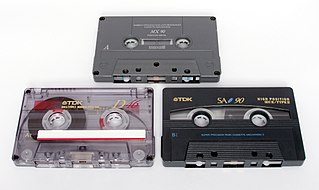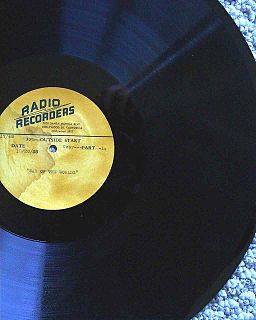
Magnetic tape is a medium for magnetic recording, made of a thin, magnetizable coating on a long, narrow strip of plastic film. It was developed in Germany in 1928, based on magnetic wire recording. Devices that record and playback audio and video using magnetic tape are tape recorders and video tape recorders respectively. A device that stores computer data on magnetic tape is known as a tape drive.

The Compact Cassette or Musicassette (MC), also commonly called the tape cassette, cassette tape, audio cassette, or simply tape or cassette, is an analog magnetic tape recording format for audio recording and playback. It was developed by the Dutch company Royal Philips in Hasselt, Belgium, by Lou Ottens and his team. It was introduced in September 1963. Compact Cassettes come in two forms, either already containing content as a prerecorded cassette (Musicassette), or as a fully recordable "blank" cassette. Both forms have two sides and are reversible by the user.

An audio tape recorder, also known as a tape deck, tape player or tape machine or simply a tape recorder, is a sound recording and reproduction device that records and plays back sounds usually using magnetic tape for storage. In its present-day form, it records a fluctuating signal by moving the tape across a tape head that polarizes the magnetic domains in the tape in proportion to the audio signal. Tape-recording devices include the reel-to-reel tape deck and the cassette deck, which uses a cassette for storage.
Analog recording is a technique used for the recording of analog signals which, among many possibilities, allows analog audio for later playback.

Ampex is an American electronics company founded in 1944 by Alexander M. Poniatoff as a spin-off of Dalmo-Victor. The name AMPEX is a portmanteau, created by its founder, which stands for Alexander M. Poniatoff Excellence. Today, Ampex operates as Ampex Data Systems Corporation, a subsidiary of Delta Information Systems, and consists of two business units. The Silicon Valley unit, known internally as Ampex Data Systems (ADS), manufactures digital data storage systems capable of functioning in harsh environments. The Colorado Springs, Colorado unit, referred to as Ampex Intelligent Systems (AIS), serves as a laboratory and hub for the company's line of industrial control systems, cyber security products and services and its artificial intelligence/machine learning technology.

Cellulose acetate refers to any acetate ester of cellulose, usually cellulose diacetate. It was first prepared in 1865. A bioplastic, cellulose acetate is used as a film base in photography, as a component in some coatings, and as a frame material for eyeglasses; it is also used as a synthetic fiber in the manufacture of cigarette filters and playing cards. In photographic film, cellulose acetate film replaced nitrate film in the 1950s, being far less flammable and cheaper to produce.

An acetate disc is a type of gramophone record generally used from the 1930s to the late 1950s for recording and broadcast purposes and still in limited use today.
TDK Corporation is a Japanese multinational electronics company that manufactures electronic materials, electronic components, and recording and data-storage media. Its motto is "Contribute to culture and industry through creativity".
Preservation of documents, pictures, recordings, digital content, etc., is a major aspect of archival science. It is also an important consideration for people who are creating time capsules, family history, historical documents, scrapbooks and family trees. Common storage media are not permanent, and there are few reliable methods of preserving documents and pictures for the future.

Sound recording and reproduction is an electrical, mechanical, electronic, or digital inscription and re-creation of sound waves, such as spoken voice, singing, instrumental music, or sound effects. The two main classes of sound recording technology are analog recording and digital recording.

Chromium dioxide or chromium(IV) oxide is an inorganic compound with the formula CrO2. It is a black synthetic magnetic solid. It once was widely used in magnetic tape emulsion. With the increasing popularity of CDs and DVDs, the use of chromium(IV) oxide has declined. However, it is still used in data tape applications for enterprise-class storage systems. It is still considered by many oxide and tape manufacturers to have been one of the best magnetic recording particulates ever invented.

Magnetophone, or simply Magnetophon, was the brand or model name of the pioneering reel-to-reel tape recorder developed by engineers of the German electronics company AEG in the 1930s, based on the magnetic tape invention by Fritz Pfleumer. AEG created the world's first practical tape recorder, the K1, first demonstrated in Germany in 1935 at the Berlin Radio Show.
EMTEC is part of the Dexxon Group headquartered in Gennevilliers, France and markets consumer computer data storage products and other computer related consumables. Dexxon Group's North American subsidiary, Dexxon Digital Storage Inc. is located in Lewis Center, Ohio. EMTEC evolved from BASF Magnetics producing magnetic tapes. Between 1998 and 2002 all of BASF's cassette lineup were rebranded EMTEC. While cassette manufacture has since ceased in 2005, and reel-to-reel tape operations were sold to RMGI, EMTEC continues to manufacture other recordable media such as optical discs, MiniDV and VHS cassettes, USB 2.0 and 3.0 Flash Drives. The Flash drives come in a variety of storage sizes. Distribution channels have decreased and EMTEC presence in the market is a shadow of its former BASF self. Since its sale by BASF, EMTEC has undergone several transformations.

Quantegy Inc. was a manufacturer of magnetic tape and professional external hard drives based in Opelika, Alabama. Their tape products were primarily used in analog audio and video recording studios, but they also have some use with digital data storage devices and instrumentation recorders along with some audiophile home hobbyists.

Recording Media Group International B.V., sometimes also named as Recordable Media Group International was a Dutch manufacturer of magnetic tape products based in Oosterhout. This plant was initially built by Philips in 1968, and spun off into a joint venture with DuPont, PDM which lasted until 1993. At this point, unknown foreign investor took over the plant and named the company Magnetic Products Oosterhout B.V. In 2004, the company became known by its current name after acquiring equipment, processes, and talent from EMTEC's Munich plant. For its entire existence, the factory has produced magnetic tape for recording audio and video. Production of video and digital audio tapes were later ended and company concentrated only on production of high-quality analog magnetic tapes for both reel-to-reel and cassette recorders. Production of cassette tape stock were later ended as well.

Preservation of magnetic audiotape comprises techniques for handling, cleaning and storage of magnetic audiotapes in an archival repository. Multiple types of magnetic media exist but are mainly in the form of open reels or enclosed cassettes. Although digitization of materials on fragile magnetic media in library and information science is a common practice, there remains a need for conserving the actual physical magnetic tape and playback equipment as artifacts.
In the field of audio recording, an aluminum disc is a phonograph record made of bare aluminum, a medium introduced in the late 1920s for making one-off recordings. Although sometimes used for making amateur studio or home recordings or in coin-operated "record-your-voice" booths at fairs and arcades, during the first half of the 1930s bare aluminum discs were primarily used to record radio broadcasts for the private transcription disc archives of performers or sponsors.
Direct-to-disc recording refers to sound recording methods that bypass the use of magnetic tape recording and record audio directly onto analog disc masters.

Sticky-shed syndrome is a condition created by the deterioration of the binders in a magnetic tape, which hold the ferric oxide magnetizable coating to its plastic carrier, or which hold the thinner back-coating on the outside of the tape. This deterioration renders the tape unusable. Some kinds of binder are known to break down over time, due to the absorption of moisture (hydrolysis).

Electrical transcriptions are special phonograph recordings made exclusively for radio broadcasting, which were widely used during the "Golden Age of Radio". They provided material—from station-identification jingles and commercials to full-length programs—for use by local stations, which were affiliates of one of the radio networks.














